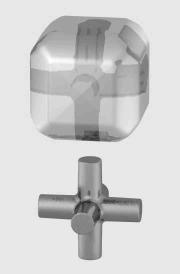Computer animation
Computer animation is the process used to generate animated images by using computer graphics. The more general term computer-generated imagery (CGI) encompasses both static scenes and dynamic images, while computer animation only refers to moving images. Modern computer animation usually uses 3D computer graphics, although 2D computer graphics are still used for stylistic, low bandwidth, and faster real-time renderings. Sometimes, the target of the animation is the computer itself, but sometimes the target is another medium, such as film.
History[edit | edit source]
The history of computer animation began as early as the 1940s and 1950s, when people began to experiment with computer graphics - most notably by John Whitney. It was only by the early 1960s when digital computers had become widely established, that new avenues for innovative computer graphics blossomed. Ivan Sutherland's Sketchpad in 1963, the first interactive computer graphics program, and the 1968 paper on the Fundamental Techniques for Computer Graphics by Sutherland laid the foundation for much of the computer animation that followed.
In the 1970s, computer animation developed further, thanks to films like Westworld (1973), which was the first to use 3D wire-frame imagery, and Futureworld (1976), which featured a computer-animated hand and face both created by then University of Utah graduate students Edwin Catmull and Fred Parke. This period also saw the rise of computer animation companies like Pixar, originally a part of Lucasfilm.
By the 1980s, CGI was being regularly used in television for special effects, and the film Tron (1982) was one of the first major films to use extensive CGI, although the bulk of its effects were still hand-drawn.
The 1990s saw an explosion in the use of computer animation, due to advancements in computing power and the advent of high-quality rendering software and techniques. Toy Story (1995), produced by Pixar, was the first feature-length film made entirely with CGI.
Techniques[edit | edit source]
Computer animation can be created with a computer and animation software. Some impressive animation can be achieved even with basic programs; however, the rendering can take a lot of time on an ordinary home computer. Professional animators of movies, television, and video sequences on computer games make use of more sophisticated software and hardware.
2D Animation[edit | edit source]
2D animation figures are created or edited on the computer using 2D bitmap graphics or created and edited using 2D vector graphics. This includes automated computerized versions of traditional animation techniques such as of tweening, morphing, onion skinning, and interpolated rotoscoping.
3D Animation[edit | edit source]
3D animation is digitally modeled and manipulated by an animator. The animator usually starts by creating a 3D polygon mesh to manipulate. A mesh typically includes many vertices that are connected by edges and faces, which give the visual appearance of form to a 3D object or environment. Special software can be used to build 3D characters and environments for animated films, television shows, and video games. The 3D model can then be animated in a variety of ways.
Applications[edit | edit source]
Computer animation is used extensively in a variety of fields, including entertainment (in movies, television, and video games), advertising, virtual reality, and simulation (for training and educational purposes). It is also used in the development of digital doubles for live-action movies and for characters in animated films.
Future[edit | edit source]
The future of computer animation presents a vast array of opportunities and challenges. Advancements in virtual reality, augmented reality, and artificial intelligence are expected to play a significant role in the development of new animation techniques. Additionally, the increasing power of personal computers and the development of more sophisticated software are making animation more accessible to the masses, potentially leading to an explosion in user-generated content.
Search WikiMD
Ad.Tired of being Overweight? Try W8MD's physician weight loss program.
Semaglutide (Ozempic / Wegovy and Tirzepatide (Mounjaro / Zepbound) available.
Advertise on WikiMD
|
WikiMD's Wellness Encyclopedia |
| Let Food Be Thy Medicine Medicine Thy Food - Hippocrates |
Translate this page: - East Asian
中文,
日本,
한국어,
South Asian
हिन्दी,
தமிழ்,
తెలుగు,
Urdu,
ಕನ್ನಡ,
Southeast Asian
Indonesian,
Vietnamese,
Thai,
မြန်မာဘာသာ,
বাংলা
European
español,
Deutsch,
français,
Greek,
português do Brasil,
polski,
română,
русский,
Nederlands,
norsk,
svenska,
suomi,
Italian
Middle Eastern & African
عربى,
Turkish,
Persian,
Hebrew,
Afrikaans,
isiZulu,
Kiswahili,
Other
Bulgarian,
Hungarian,
Czech,
Swedish,
മലയാളം,
मराठी,
ਪੰਜਾਬੀ,
ગુજરાતી,
Portuguese,
Ukrainian
Medical Disclaimer: WikiMD is not a substitute for professional medical advice. The information on WikiMD is provided as an information resource only, may be incorrect, outdated or misleading, and is not to be used or relied on for any diagnostic or treatment purposes. Please consult your health care provider before making any healthcare decisions or for guidance about a specific medical condition. WikiMD expressly disclaims responsibility, and shall have no liability, for any damages, loss, injury, or liability whatsoever suffered as a result of your reliance on the information contained in this site. By visiting this site you agree to the foregoing terms and conditions, which may from time to time be changed or supplemented by WikiMD. If you do not agree to the foregoing terms and conditions, you should not enter or use this site. See full disclaimer.
Credits:Most images are courtesy of Wikimedia commons, and templates, categories Wikipedia, licensed under CC BY SA or similar.
Contributors: Prab R. Tumpati, MD




